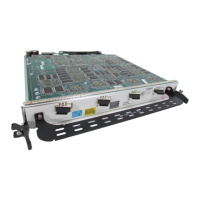Implementing Multicast Routing on Cisco IOS XR Software Cisco ASR 9000 Series Routers
Information About Implementing Multicast Routing
MCC-14
Multicast Configuration Guide
OL-
Multicast VPN Routing and Forwarding
Dedicated multicast routing and forwarding tables are created for each VPN to separate traffic in one
VPN from another.
The VPN-specific multicast routing and forwarding database is referred to as MVRF. On a PE router, an
MVRF is created when multicast is enabled for a VRF. Protocol Independent Multicast (PIM), and
Internet Group Management Protocol (IGMP) protocols run in the context of MVRF, and all routes
created by an MVRF protocol instance are associated with the corresponding MVRF. In addition to
VRFs, which hold VPN-specific protocol states, a PE router always has a global VRF instance,
containing all the routing and forwarding information for the provider network.
Multicast Distribution Tree Tunnels
The multicast distribution tree (MDT) can span multiple customer sites and the provider network,
allowing traffic to flow from one source to multiple receivers.
Secure data transmission is achieved by encapsulating multicast packets in a provider header from the
sending customer edge (CE) router at the ingress PE router and transmitting the packets across the core.
At the egress PE router, the encapsulated packets are decapsulated then sent to the CE receiving routers.
Multicast distribution tree (MDT) tunnels are point-to-multipoint. Packets sent to an MDT tunnel
interface are received by multiple receiving routers. Packets sent to an MDT tunnel interface are
encapsulated, and packets received from a MDT tunnel interface are decapsulated.
Figure 5 shows a
virtual peer connection between two PE routers over an MDT tunnel interface.
Figure 5 Virtual PIM Peer Connection over an MDT Tunnel Interface
Encapsulating multicast packets in a provider header allows PE routers to be unaware of the packet
origin—all VPN packets passing through the provider network are viewed as native multicast packets
and are routed based on the routing information in the core network. PE routers only need to support
native multicast routing to support MVPN.
MVPN also supports optimized VPN traffic forwarding for high-bandwidth applications that have
sparsely distributed receivers. A dedicated multicast group can be used to encapsulate packets from a
specific source, and an optimized MDT can be created to send traffic only to PE routers with interested
receivers. This is referred to as data MDT.
CE
Sender Receiver
PE PE
CE
MDT tunnel
Service provider
encapsulation decapsulation
210654

